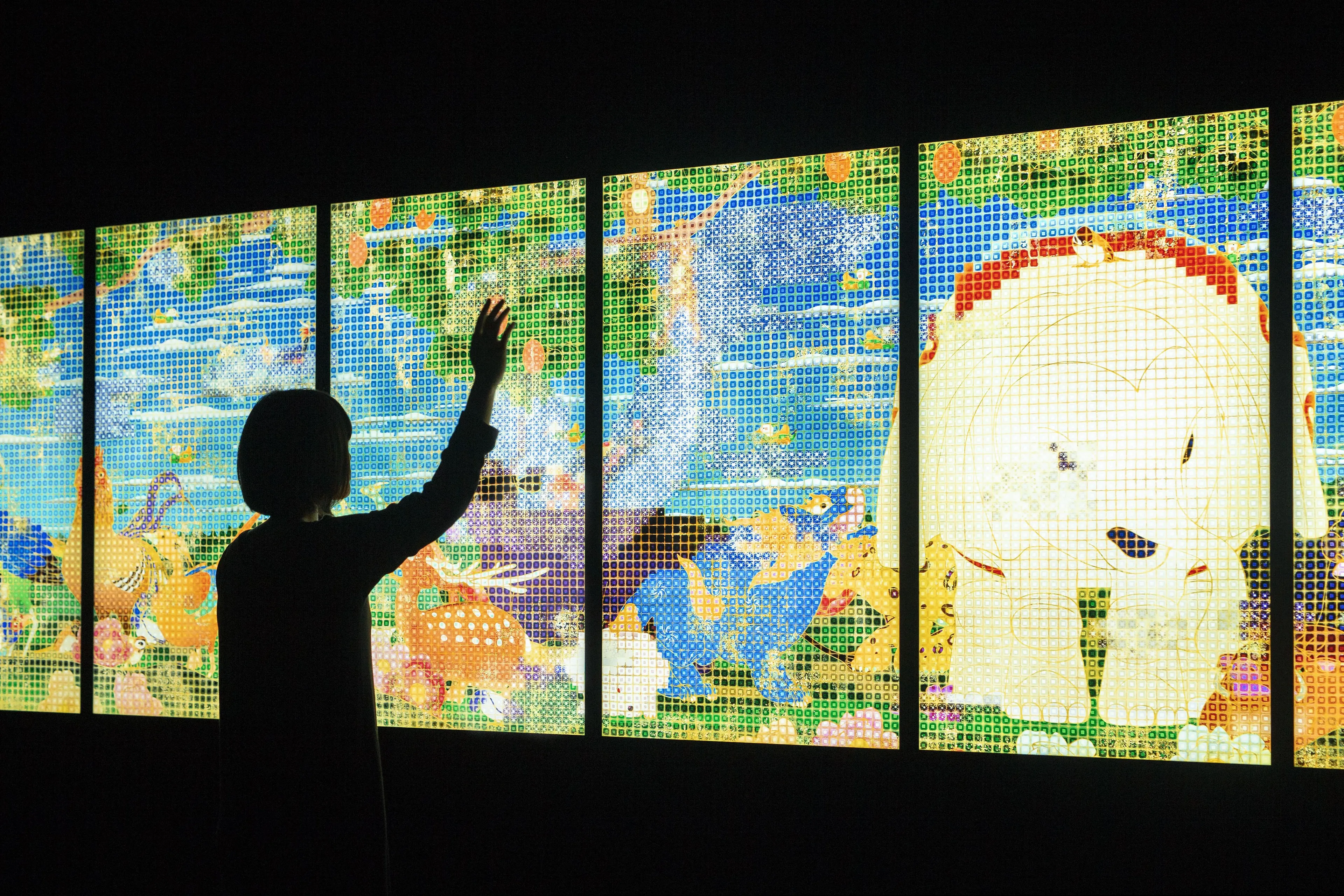Zipangu – Contemporary artists who have run through the Heisei era | teamLab

Zipangu – Contemporary artists who have run through the Heisei era
المعارض السابقة

Zipangu – Contemporary artists who have run through the Heisei era
المعارض السابقة
حول تيم لاب
"تيم لاب" هو عبارة عن مجموعة فنيّة عالمية (تأسست عام 2001)، يتم التعاون فيها بهدف التعمّق في نقاط الالتقاء بين الفن والعلوم والتكنولوجيا والعالم الطبيعي. فعبر الأعمال الفنيّة، تهدف مجموعة من الخبراء ذوي الاختصاصات المختلفة، بمن فيهم فنانين ومبرمجين ومهندسين، وأخصائي رسوم متحركة، وعلماء رياضيات ومهندسين معماريين، إلى استكشاف العلاقة بين الذات والعالم وأشكال جديدة من الإدراك.
وفي محاولة إلى فهم العالم حولهم، يسعى الناس إلى فصله إلى وحدات مستقلة يتصوّرون حدودًا في ما بينها. ولكن "تيم لاب" يسعى إلى تجاوز هذه الحدود التي تحدّ رؤيتنا ونظرتنا إلى العالم وإلى العلاقة بين الذات والعالم واستمرارية الزمن. فكل شيء قائم في استمرارية بلا حدود، في استمرارية مستدامة وهشّة وخارقة في آن واحد.
تتواجد أعمال "تيم لاب" من ضمن المجموعة الدائمة لمعرض فكتوريا الوطني في ملبورن، ومعرض الفنون نيو ساوث ويلز في سيدني، ومعرض فنون جنوب أستراليا في أديلايد، ومعرض أستراليا الوطني في كانبيرا، ومتحف الفنون آموس ريكس في هلسنكي، ومتحف الفن المعاصر في لوس أنجلوس، ومتحف الفن الآسيوي في سان فرانسيسكو، ومتحف مجموعة بوروسان للفن المعاصر في إسطنبول، وجمعية متحف آسيا في نيويورك، وغيرها.
تيم لاب
وثائق السيرة الذاتية
يتم تمثيل أعمال "تيم لاب" من قبل معرض بايس، ومعرض مارتن براون للفنون المعاصرة، ومعرض إيكان للفنون.
EXHIBITION OVERVIEW
Zipangu – Contemporary artists who have run through the Heisei era
The Heisei era is sometimes called the "Lost 30 Years," but it was also a time when exceptional talent in fashion, architecture, anime, manga, and contemporary art flourished, earning global recognition.
This exhibition offers a chronological exploration of Japanese contemporary art that emerged during the Heisei era. It is a restructured and expanded version of the "Zipangu" exhibition, originally held in Japan in 2011-2012.
The original Zipangu exhibition aimed to rediscover the allure of Japanese contemporary art. It also sought to heal and rejuvenate Japan through the power of art in the wake of the Great East Japan Earthquake.
In this updated Zipangu exhibition, we bring together works from leading artists who have shaped the art world from the Heisei era into the Reiwa era. These artists have developed unique expressions by blending and transforming Japanese culture within the broader context of global contemporary art. Their works reflect the complexity and diversity of their times.
As you explore the art on display, we invite you to reflect on the Heisei era and enjoy the contemporary art that continues to evolve today. (from Exhibition page)
The Heisei era is sometimes called the "Lost 30 Years," but it was also a time when exceptional talent in fashion, architecture, anime, manga, and contemporary art flourished, earning global recognition.
This exhibition offers a chronological exploration of Japanese contemporary art that emerged during the Heisei era. It is a restructured and expanded version of the "Zipangu" exhibition, originally held in Japan in 2011-2012.
The original Zipangu exhibition aimed to rediscover the allure of Japanese contemporary art. It also sought to heal and rejuvenate Japan through the power of art in the wake of the Great East Japan Earthquake.
In this updated Zipangu exhibition, we bring together works from leading artists who have shaped the art world from the Heisei era into the Reiwa era. These artists have developed unique expressions by blending and transforming Japanese culture within the broader context of global contemporary art. Their works reflect the complexity and diversity of their times.
As you explore the art on display, we invite you to reflect on the Heisei era and enjoy the contemporary art that continues to evolve today. (from Exhibition page)
تفاصيل المكان
Zipangu – Contemporary artists who have run through the Heisei era
الفترة
12.22(Sun) - 2024.11.02(Sat)
الوقت
9:00 - 17:00 (Last entry 16:30)
العطل
Open every day during the exhibition period
رسوم الدخول
Adults ¥2,000
Students ¥1,000
Children ¥500
*Student:Senior high / College students, Children:Primary / Secondary students
*This ticket is also valid for the Collection Galleries.
*Seniors (65+) can apply for ¥200 discount on the Individual Adults ticket price.
*Admission free for visitors with a disability certificate, including one accompanying person.
Students ¥1,000
Children ¥500
*Student:Senior high / College students, Children:Primary / Secondary students
*This ticket is also valid for the Collection Galleries.
*Seniors (65+) can apply for ¥200 discount on the Individual Adults ticket price.
*Admission free for visitors with a disability certificate, including one accompanying person.
موقع ويب
وسائل المواصلات
العنوان
Hiroshima Museum of Art
3 - 2 Motomachi, Naka-ku, Hiroshima
3 - 2 Motomachi, Naka-ku, Hiroshima
العنوان باللغة المحلية:
ひろしま美術館
広島市中区基町3-2 中央公園内
広島市中区基町3-2 中央公園内
المنظمون
Hiroshima Museum of Art



